In the world of online marketing, a keyword gap analysis is most associated with SEO, where a company will compare the keywords their website is ranking for against their competitors’ keywords to identify any areas that the competitor ranks for that they don’t. The goal is to find keywords their competitors are outperforming them for and develop a strategy to catch up.
Aside from the word “ranking” and assuming it also translates to “performance,” there’s nothing to say that this process couldn’t be applicable to paid media campaigns as well. Or that only keywords your competitors are bidding on are valuable.
In this article, I want to talk about how we can use (mostly free) tools to do a similar process of keyword discovery for paid search campaigns and discuss why you may want to do so.
Contents
Why do a keyword gap analysis for PPC?
Whether you’re trying to find new keywords through your own search terms or are looking at where competitors are bidding, keyword discovery is a great way to ensure your paid search accounts are alive and evolving. Odds are that the initial keyword research you did when you launched your campaigns is still applicable. But over time, things change.
Google continues to assert that 15% of queries every day are brand new, never before seen by their system.

Whether you leverage your search terms to see how queries evolve or if you piggyback off the work your competitors are doing, this type of gap analysis can ensure that you’re moving with your customer base and not staying stagnant while everyone leaves you behind.
👀 Want a quick look at how your Google Ads are doing? Try our Free Google Ads Performance Grader for an instant audit!
How to do a keyword gap analysis to improve PPC campaigns: Step by step
Follow these steps to perform a keyword gap analysis you can use to optimize your search campaigns.
1. Take stock of your existing keywords
We’ll get to your competitors in a minute, but the first place I always encourage advertisers to look for new keywords is in their Search Terms Report.
In Google Ads, this is under the Insights and Reports section of the interface, and all the terms here are queries you’re already showing up for.
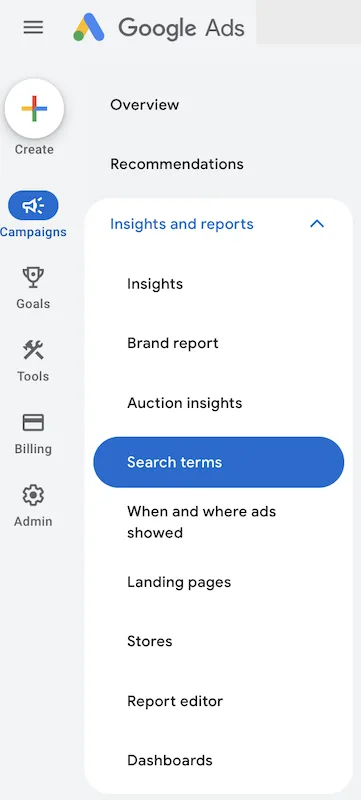

Once you’re there, there’s a simple filter that will help you find only net new terms to your account. Either navigate to the Attributes dropdown or search for “Add” in the filters like I did in the image above, and choose the Added/Excluded option from the dropdown.
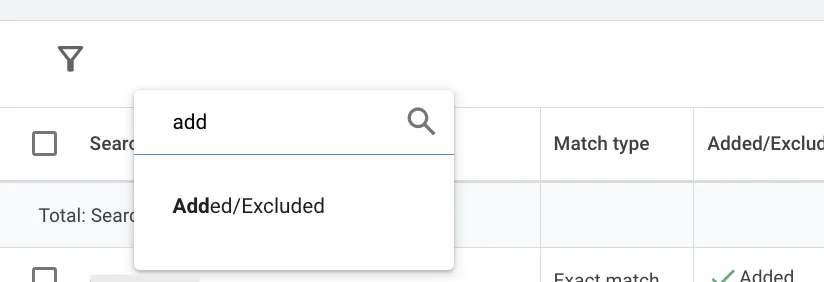

From there, check the box next to None. This will show you only search terms that your ads are showing for that you’ve not added as keywords already or that aren’t added as negative keywords.
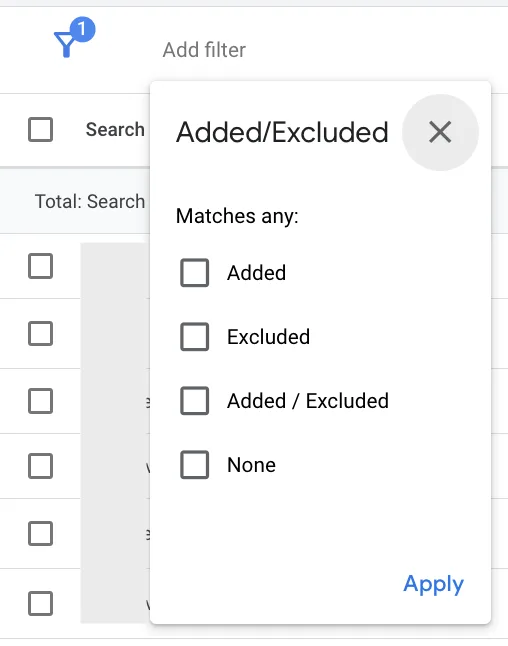

The benefit to this is that you’re likely finding new variants of relevant terms that your customers are actively searching for. They’re likely a good fit for your business (assuming you do regular negative keyword reviews), and they are guaranteed to have search volume since you’re already seeing it in your account.
Additionally, although Google always suggests getting rid of terms that are “duplicates,” even though they’re not identical, they still reward advertisers for having the Exact match to a query in the account. It’s laid out in their prioritization documents. If a query is the exact same as a keyword in your account and another is close, but not identical, then the exact version will have a higher Ad Rank and have a better chance of matching.


🔎 Need help finding the right keywords for your campaigns? Try our Free Keyword Tool!
2. Gather your competitors
The first stage in this process is to get a list of competitors you want to use to review for gaps. There are two different types of competitors I want you to think about for this exercise.
- Traditional competitors: These are companies that do the same things you do, and you likely compete directly for the same customers. Think large brands like Dunkin’ and Starbucks, or smaller scale like one roofing company vs another.
- Active advertisers: These are the companies that are bidding on your keywords. For this, conduct a simple search with your existing keywords and see who comes up. These are folks that you are literally competing with in search, even if they don’t do the same things you do.
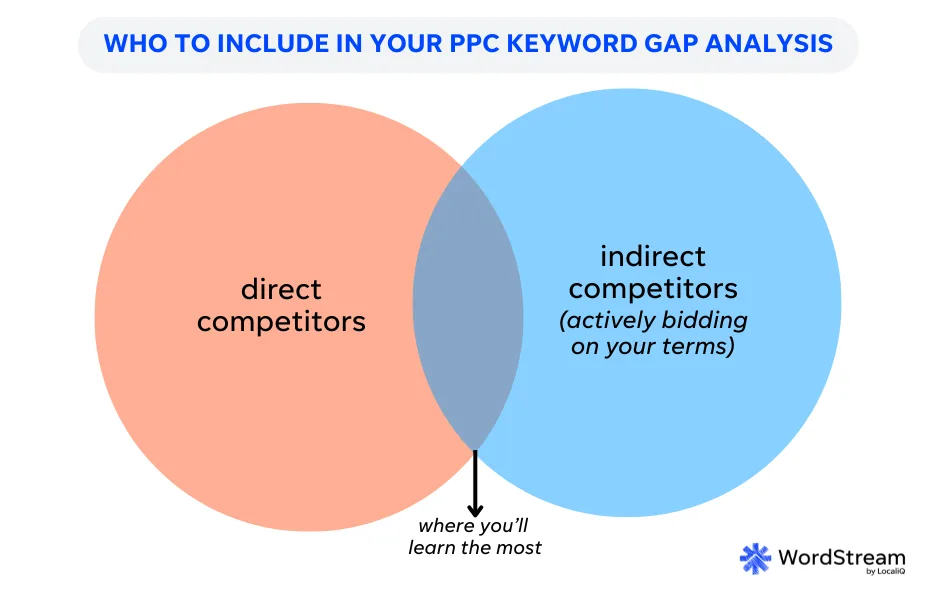

The reason we use both groups is because of the diagram above. There are some companies that are direct competitors and they aren’t bidding against you, others that aren’t really competitors but are bidding against you, and the group we’ll likely learn the most from is the cross-section of the two: those who are your competitors and are bidding on your terms.
🕵️♀️ Want an even deeper look at what your competitors are doing? Free guide >> How to Spy on Your Competitors: 7 Ways to Become a Competitive Supersleuth
3. Scan the websites
Now that we have our list of competitors, we’re going to use their websites for some light snooping.
We’re going to use the Google Ads Keyword Planner and select the “Start with a Website” option and input each of the sites from the competitor.


The results listed will show all the keywords Google thinks the website is about. This can give you all sorts of ideas based just on the content of your competitor’s site.
The best part: there’s a column on the far right that will show you if you already have a keyword in your account or not. This is a very quick way for you to review a keyword for relevancy and then to easily check if you’ve already been using it or if it’s a new term you can test out.


At times, a company’s entire website can be a bit broad. If you’re finding lots of irrelevant terms but you’re confident the company is relevant to your business, try using individual pages from the site rather than the whole site. If possible, even grab some of their landing pages and run those through the tool to see what you can come up with.
A PPC keyword gap analysis example
While the Google Ads Keyword Planner can be a great tool for identifying new terms and easily comparing them to your accounts, I’m a really big fan of the functionality in some of the paid research tools out there. One of my favorites is SpyFu, but others have similar functionality.
With SpyFu, you can take all of your competitors (direct or indirect), put their websites into the tool, and see all sorts of information about their paid search campaigns.
Here are some of the data points you can see:
- Search terms their ads have shown for
- Average ad budget
- Number of active keywords
Caveat before we go further: All of this is inferred data. SpuFu can’t actually know what a competitor’s keywords are or how much they spend. They can only see the search terms an advertiser showed up for and reverse engineer the number of active keywords and ad budget from there.
While this data isn’t perfect, there’s still plenty we can learn from it. So if you can accept this caveat, which you should, then keep reading.
Still here?
Great!
Let’s start by taking an example website, Lowes.com. (Yes, I’ve been doing home improvement projects, so Lowe’s is top of mind.
If we input lowes.com into SpuFu, then navigate to the PPC Research section, then choose PPC Keywords, we’ll see a report that looks like this. It has the top performing PPC search queries that Lowes has been showing up for.
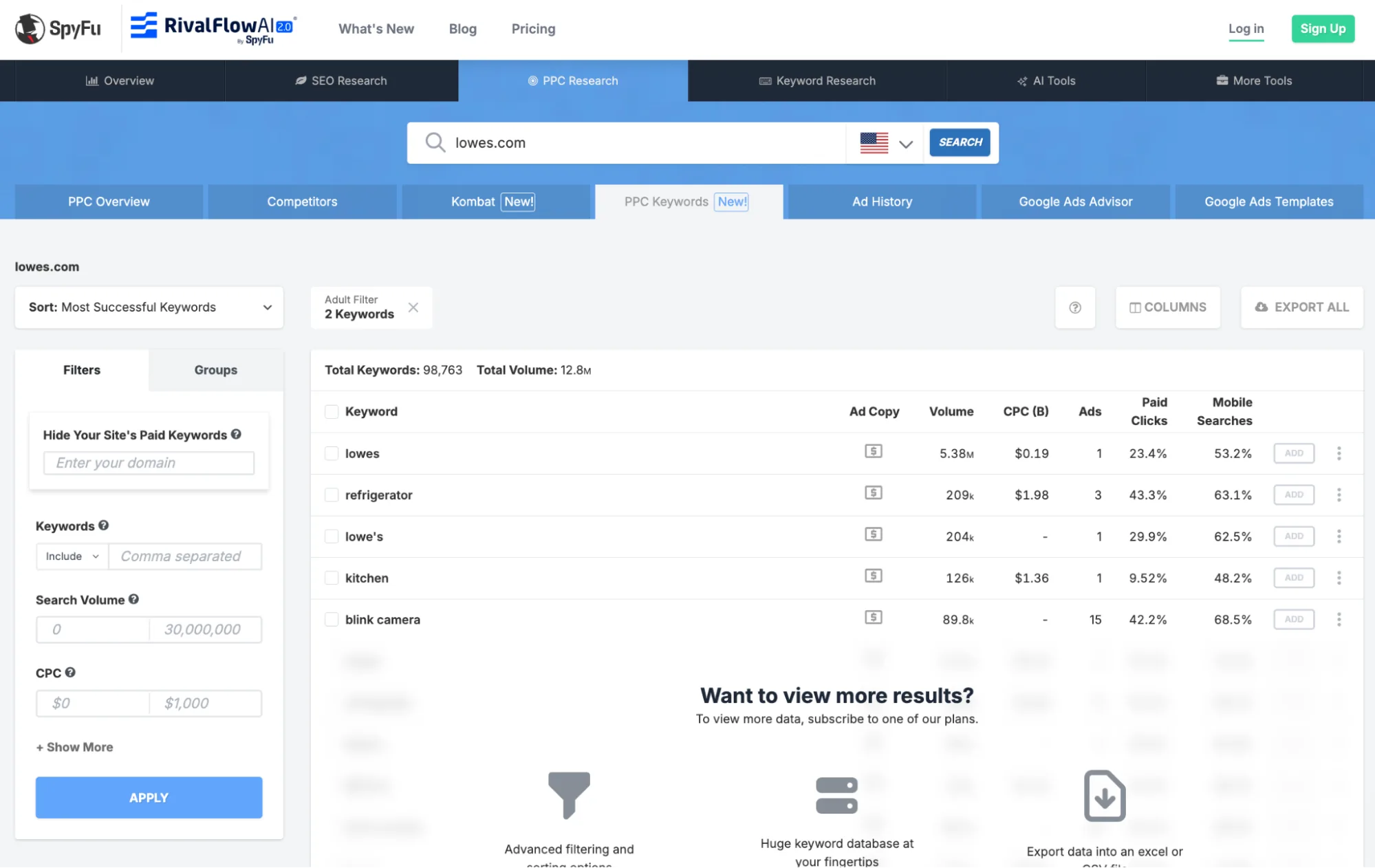

As you can see, the report is truncated to only the top five terms since we’re in a free account, but if you were to pay for SpyFu, you’d see a lot more variants show up here.
Each of these terms could be a valuable keyword for you to target if you’re a competitor of Lowe’s and want to show up in the same SERPs that they are. A similar process can be done for all of your competitors to find the top terms they show up for and try to take some new themes for yourself.
That said, my favorite report in SpyFu is the Kombat report. On this tab, you can input multiple competitors, then see how their search term coverage overlaps in a Venn Diagram.


Here, you can see Home Depot and Menards’ search term coverage against Lowe’s. There’s a group of 118 “Core Keywords,” meaning all three brands bid on these terms.
But the gems come from seeing which terms either Home Depot or Menards bid on that Lowe’s doesn’t. Specifically, the “Consider Buying” section, in this instance with 70 keywords, shows the search terms Home Depot and Menards are showing for that Lowe’s isn’t.


In this instance, two competitors are showing for the above terms, while Lowe’s is left out. If you’re the Paid Search Manager for Lowe’s and you know you offer Owens Corning Duration Shingles, that might be a good term for you to look into.
Additionally, three of the five listed terms are for “appliances” plus a city, state location. That could be an entire keyword theme Lowe’s should look into researching and building out to ensure they have coverage for folks looking for appliances in areas where they have stores.
Again, these are only the queries Home Depot and Menards are showing for, not the specific keywords, but they’re both onto something with the location terms, and it appears Lowe’s is being left out of that market conversation. Probably a good place to at least investigate and see if this should be added to their paid search coverage.
Look for new opportunities with a PPC keyword gap analysis
A keyword gap analysis can help you identify new areas for your search campaigns to reach potential customers based on what your competitors are doing. By following these simple steps, you can discover opportunities to expand your keyword lists and optimize your campaigns. Need help with your Google Ads? Reach out for a demo to see how we can help.











